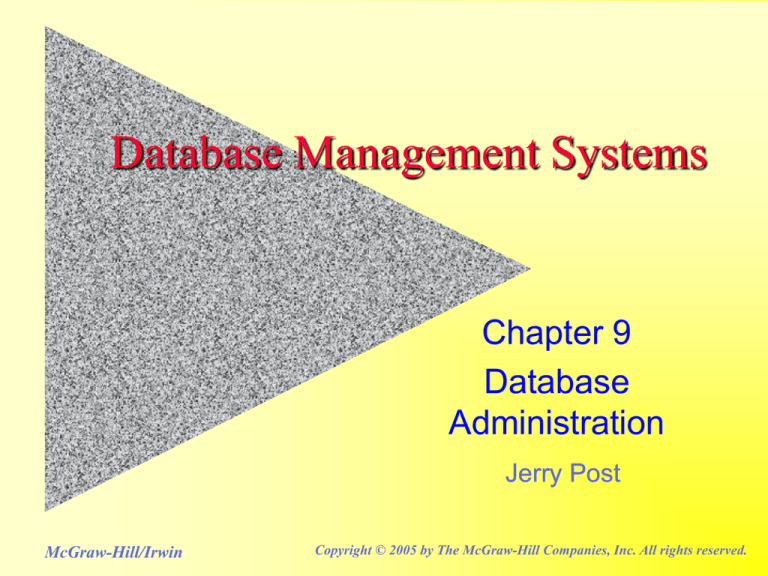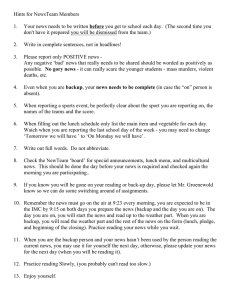
Database Management Systems
Chapter 9
Database
Administration
Jerry Post
McGraw-Hill/Irwin
Copyright © 2005 by The McGraw-Hill Companies, Inc. All rights reserved.
D
A
T
A
B
A
S
E
Data Administration
Data and information are valuable
assets.
There are many databases and
applications in an organization.
Someone has to be responsible for
organizing, controlling, and sharing data.
Data Administrator (DA)
2
D
A
T
A
B
A
S
E
Data Administrator (DA)
Provide centralized control over the data.
Data definition.
Format
Naming convention
Data integration.
Selection of DBMS.
Act as data and database advocate.
Application ideas.
Decision support.
Strategic uses.
Coordinate data integrity, security, privacy, and control.
3
D
A
T
A
B
A
S
E
Database Administrator (DBA)
Install and upgrade DBMS.
Create user accounts and monitor security.
In charge of backup and recovery of the database.
Monitor and tune the database performance.
Coordinate with DBMS vendor and plan for changes.
Maintain DBMS-specific information for developers.
4
D
A
T
A
B
A
S
E
Database Structure
Database
Users and Permissions
Catalog: (very rare)
Schema
Table
Columns
Data types
Constraints
Views
Triggers
Routines and Modules
…
The schema is a
namespace often
assigned to users
so that table names
do not have to be
unique across the
entire database.
The catalog is a
container with the
goal of making it
easier to find
schema, but is
probably not
supported by any
DBMS yet.
5
D
A
T
A
B
A
S
E
Metadata
Data about data
Example: a system table
that contains a list of user
tables.
SQL standard uses the
information_schema views
that retrieve data from the
definition_schema
SELECT Table_Name, Table_Type
FROM Information_Schema.Tables
WHERE table_name LIKE ‘Emp%’
Information_Schema Examples
(61 total views)
Schemata
Tables
Domains
Views
Table_Privileges
Referential_Constraints
Check_Constraints
Triggers
Trigger_Table_Usage
Parameters
Routines
6
D
A
T
A
B
A
S
E
Database Administration
Planning
Determine hardware and software needs.
Design
Estimate space requirements, estimate performance.
Implementation
Install software, create databases, transfer data.
Operation
Monitor performance, backup and recovery.
Growth and Change
Monitor and forecast storage needs.
Security
Create user accounts, monitor changes.
7
D
A
T
A
B
A
S
E
Database Planning
Estimation
Data storage requirements
Time to develop
Cost to develop
Operations costs
8
D
A
T
A
B
A
S
E
Managing Database Design
Teamwork
Data standards
Data repository
Reusable objects
CASE tools
Networks / communication
Subdividing projects
Delivering in stages
User needs / priorities
Version upgrades
Normalization by user views
Distribute individual sections
Combine sections
Assign forms and reports
9
D
A
T
A
B
A
S
E
Database Implementation
Standards for application
programming.
User interface.
Programming standards.
Layout and techniques.
Variable & object definition.
Test procedures.
Data access and ownership.
Loading databases.
Backup and recovery plans.
User and operator training.
10
D
A
T
A
B
A
S
E
Database Operation and Maintenance
Monitoring usage
Size and growth
Performance / delays
Security logs
User problems
Backup and recovery
User support
Help desk
Training classes
11
D
A
T
A
B
A
S
E
Database Growth and Change
Detect need for change
Size and speed
Structures / design
Requests for additional data.
Difficulties with queries.
Usage patterns
Forecasts
Delays in implementing changes
Time to recognize needs.
Time to get agreement and approval.
Time to install new hardware.
Time to create / modify software.
12
D
A
T
A
B
A
S
E
Backup and Recovery
Backups are crucial!
Offsite storage!
Scheduled backup.
Regular intervals.
Record time.
Track backups.
Snapshot
Journals / logs
Checkpoint
Rollback / Roll forward
Journal/Log
Changes
OrdID Odate Amount ...
192
2/2/01 252.35 …
193
2/2/01 998.34 …
OrdID
192
193
194
Odate Amount ...
2/2/01 252.35 …
2/2/01 998.34 …
2/2/01
77.23 ...
OrdID
192
193
194
195
Odate Amount ...
2/2/01 252.35 …
2/2/01 998.34 …
2/2/01
77.23 …
2/2/01 101.52 …
13
D
A
T
A
B
A
S
E
Database Security and Privacy
Physical security
Protecting hardware
Protecting software and
data.
Logical security
Unauthorized disclosure
Unauthorized modification
Unauthorized withholding
Security Threats
Employees / Insiders
Disgruntled employees
“Terminated” employees
Dial-up / home access
Programmers
Time bombs
Trap doors
Visitors
Consultants
Business partnerships
Strategic sharing
EDI
Hackers--Internet
14
D
A
T
A
B
A
S
E
Data Privacy
Who owns data?
Customer rights.
International complications.
Do not release data to others.
Do not read data unnecessarily.
Report all infractions and problems.
Marketing needs
Privacy tradeoffs
Government requests
Employee management
15
D
A
T
A
B
A
S
E
Hardware
Physical Security
Preventing problems
Fire prevention
Site considerations
Building design
Hardware backup
facilities
Continuous backup
(mirror sites)
Hot sites
Shell sites
“Sister” agreements
Telecommunication
systems
Personal computers
Data and software
Backups
Off-site backups
Personal computers
Policies and procedures
Network backup
Disaster planning
Write it down
Train all new employees
Test it once a year
Telecommunications
Allowable time between
disaster and business
survival limits.
16
D
A
T
A
B
A
S
E
Physical Security Provisions
Backup data.
Backup hardware.
Disaster planning and testing.
Prevention.
Location.
Fire monitoring and control.
Control physical access.
17
D
A
T
A
B
A
S
E
Managerial Controls
“Insiders”
Hiring
Termination
Monitoring
Job segmentation
Physical access limitations
Locks
Guards and video monitoring
Badges and tracking
Consultants and Business alliances
Limited data access
Limited physical access
Paired with employees
18
D
A
T
A
B
A
S
E
Logical Security
Unauthorized disclosure.
Unauthorized modification.
Unauthorized withholding.
Disclosure example
Letting a competitor see the
strategic marketing plans.
Modification example
Letting employees change
their salary numbers.
Withholding example
Preventing a finance officer
from retrieving data needed
to get a bank loan.
19
D
A
T
A
B
A
S
E
User Identification
User identification
Accounts
Individual
Groups
Passwords
Do not use “real” words.
Do not use personal (or pet)
names.
Include non-alphabetic
characters.
Use at least 6 (8)
characters.
Change it often.
Too many passwords!
Alternative identification
Finger / hand print readers
Voice
Retina (blood vessel) scans
DNA typing
Hardware passwords
The one-minute password.
Card matched to computer.
Best method for open
networks / Internet.
20
D
A
T
A
B
A
S
E
Basic Security Ideas
3
5
Limit access to hardware
Physical locks.
Video monitoring.
Fire and environment
monitors.
Employee logs / cards.
Dial-back modems
Monitor usage
Hardware logs.
Access from network nodes.
Software and data usage.
Background checks
Employees
Consultants
2
Jones 1111
Smith 2222
Olsen 3333
Araha 4444
phone
company
Dialback modem
phone
company
4
1
User calls modem
Modem gets name, password
Modem hangs up phone
Modem calls back user
Machine gets final password
21
D
A
T
A
B
A
S
E
Access Controls
Operating system
Access to directories
Read
View / File scan
Write
Create
Delete
Access to files
Read
Write
Edit
Delete
DBMS usually needs
most of these
Assign by user or group.
DBMS access controls
Read Data
Update Data
Insert Data
Delete Data
Open / Run
Read Design
Modify Design
Administer
Owners and administrator
Need separate user
identification / login to
DBMS.
22
D
A
T
A
B
A
S
E
SQL Security Commands
GRANT privileges
REVOKE privileges
Privileges include
SELECT
DELETE
INSERT
UPDATE
Objects include
Table
Table columns (SQL 92+)
Query
GRANT INSERT
ON Bicycle
TO OrderClerks
REVOKE DELETE
ON Customer
FROM Assemblers
Users include
Name/Group
PUBLIC
23
D
A
T
A
B
A
S
E
WITH GRANT OPTION
GRANT SELECT
ON Bicycle
TO MarketingChair
WITH GRANT OPTION
Enables the recipient to also grant the
specified privilege to other users. It passes
on part of your authority.
24
D
A
T
A
B
A
S
E
Roles
ItemID
Description
Price
QOH
111
Dog Food
0.95
53
222 CustomerID
Cat Food LastName
1.23
82
FirstName
333 1111 Bird Food Wilson
3.75
18
Peta
1112
SalesID SaleDate
1113
111
03-May-
Pollock
Jackson
CustomerID
Locke
Jennifer
1112
112
04-May-
1112
113
05-May-
1113
Role: SalesClerk
Items: SELECT
Phone
2222
3333
Customers: SELECT,
UPDATE
4444
Sales: SELECT,
UPDATE, INSERT
Assign permissions
to the role.
New hire:
Add role to person
25
D
A
T
A
B
A
S
E
Using Queries for Control
Permissions apply to entire
table or query.
Use query to grant access to
part of a table.
Example
Employee table
Give all employees read
access to name and phone
(phonebook).
Give managers read access
to salary.
Employee(ID, Name, Phone, Salary)
Query: Phonebook
SELECT Name, Phone
FROM Employee
Security
Grant Read access to Phonebook
for group of Employees.
Grant Read access to Employee
for group of Managers.
SQL
Grant
Revoke
Revoke all access to Employee
for everyone else (except Admin).
26
D
A
T
A
B
A
S
E
Separation of Duties
Supplier
SupplierID Name…
673
772
983
Acme Supply
Basic Tools
Common X
Referential
integrity
Purchasing
manager can add
new suppliers,
but cannot add
new orders.
Resource
Supplier table
PurchaseOrder table
PurchaseItem table
PurchaseOrder
OrderID SupplierID
8882
8893
8895
772
673
009
Purchasing
Manager
Select, Insert
Modify, Delete
Select
Purchasing
Clerk
Select
Select, Insert
Modify, Delete
Clerk must use SupplierID
from the Supplier table,
and cannot add a new
supplier.
27
D
A
T
A
B
A
S
E
Securing an Access Database
Set up a secure workgroup
Create a new Admin user.
Enable security by setting a password
Remove the original Admin user.
Run the Security Wizard in the database to be secured.
Assign user and group access privileges in the new
database.
Encrypt the new database.
Save it as an MDE file.
28
D
A
T
A
B
A
S
E
Encryption
Protection for open transmissions
Plain text
message
Networks
The Internet
Weak operating systems
Single key (AES)
Dual key
Protection
Authentication
AES
Key: 9837362
Single key: e.g., AES
Encrypted
text
Trap doors / escrow keys
U.S. export limits
64 bit key limit
Breakable by brute force
Typical hardware:2 weeks
Special hardware: minutes
Encrypted
text
Key: 9837362
AES
Plain text
message
29
D
A
T
A
B
A
S
E
Dual Key Encryption
Message
Transmission
Message
Encrypt+T+M
Alice
Private Key
13
Use
Alice’s
Private key
Encrypt+M
Encrypt+T
Bob
Public Keys
Alice 29
Bob 17
Use
Bob’s
Public key
Use
Alice’s
Public key
Private Key
37
Use
Bob’s
Private key
Using Bob’s private key ensures it came from him.
Using Alice’s public key means only she can read it.
30
D
A
T
A
B
A
S
E
Sally’s Pet Store: Security
Management
Sally/CEO
Sales Staff
Store manager
Sales people
Business Alliances
Accountant
Attorney
Suppliers
Customers
Products
Sales
Purchases
Receive products
Employees
Hiring/Release
Hours
Pay checks
Animals
Sales
Purchases
Animal Healthcare
Accounts
Payments
Receipts
Management Reports
Operations
Users
31
D
A
T
A
B
A
S
E
Sally’s Pet Store: Purchases
Purchase
Sally/CEO
Store Mgr.
Sales people
Accountant
Attorney
Suppliers
Customers
Purchase Query
Merchandise
Order
Supplier
W/A
W/A
W/A
R*
R
R*
R
R*
R
R*
-
Employee
R: ID, Name
R: ID, Name
R: ID, Name
R: ID, Name
-
City
R
R
R
R
R
-
PurchaseItem Query
Order
Item
Merchandise
W/A
W/A
A
R
R
R
R
R
R
R
-
*Basic Supplier data: ID, Name, Address, Phone, ZipCode, CityID
R: Read
W: Write
A: Add
32
Database Management Systems
End of
Chapter 9
McGraw-Hill/Irwin
Copyright © 2005 by The McGraw-Hill Companies, Inc. All rights reserved.


